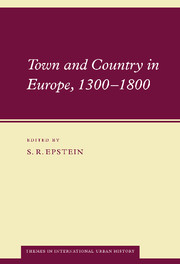Book contents
- Frontmatter
- Contents
- List of figures
- List of tables
- Notes on the contributors
- 1 Introduction. Town and country in Europe, 1300–1800
- 2 Town and country in Sweden, 1450–1650
- 3 Town and country in Holland, 1300–1550
- 4 Town and country in the Dutch Republic, 1550–1800
- 5 Town and country in England, 1300–1570
- 6 Town and country in England, 1570–1750
- 7 Town and country in the Polish Commonwealth, 1350–1650
- 8 Town and country in the Austrian and Czech lands, 1450–1800
- 9 Town and country in Germany, 1350–1600
- 10 Town and country in Switzerland, 1450–1750
- 11 Town and country in France, 1550–1750
- 12 Town and country in Castile, 1400–1650
- 13 Town and country in central and northern Italy, 1400–1800
- 14 Town and country in the kingdom of Naples, 1500–1800
- Index
2 - Town and country in Sweden, 1450–1650
Published online by Cambridge University Press: 09 November 2009
- Frontmatter
- Contents
- List of figures
- List of tables
- Notes on the contributors
- 1 Introduction. Town and country in Europe, 1300–1800
- 2 Town and country in Sweden, 1450–1650
- 3 Town and country in Holland, 1300–1550
- 4 Town and country in the Dutch Republic, 1550–1800
- 5 Town and country in England, 1300–1570
- 6 Town and country in England, 1570–1750
- 7 Town and country in the Polish Commonwealth, 1350–1650
- 8 Town and country in the Austrian and Czech lands, 1450–1800
- 9 Town and country in Germany, 1350–1600
- 10 Town and country in Switzerland, 1450–1750
- 11 Town and country in France, 1550–1750
- 12 Town and country in Castile, 1400–1650
- 13 Town and country in central and northern Italy, 1400–1800
- 14 Town and country in the kingdom of Naples, 1500–1800
- Index
Summary
Urban size and networks
In the course of the seventeenth century Sweden became one of the great European powers. Among the reasons for the country's military success was the administrative efficiency of the Swedish state, led by king and nobility in unison. The government had previously aimed to modernise society, and among its targets had been the urban system, including not only the towns but also relations between towns and their hinterland. This chapter discusses the urban policy of the Swedish state and its effects on town–country relations from the fifteenth to the mid-seventeenth century. It examines the division of labour and interactions between town and country and the institutional framework in which relations took place, including the character and consequences of town policy. The discussion ends with the first half of the seventeenth century, when the urban system within the old Swedish territory was extensively transformed and the borders of the Swedish realm changed.
Sweden was one of the least urbanised countries in Europe until the end of the nineteenth century. As late as 1850, less than 10 per cent of the population lived in towns and half of the towns had fewer than 1,500 people. While this implies a fortiori that early modern Sweden was a relatively backward country, it also reflects the country's vast size and high transport costs, which made it difficult to support a high level of urbanisation.
- Type
- Chapter
- Information
- Town and Country in Europe, 1300–1800 , pp. 30 - 53Publisher: Cambridge University PressPrint publication year: 2001
- 1
- Cited by



